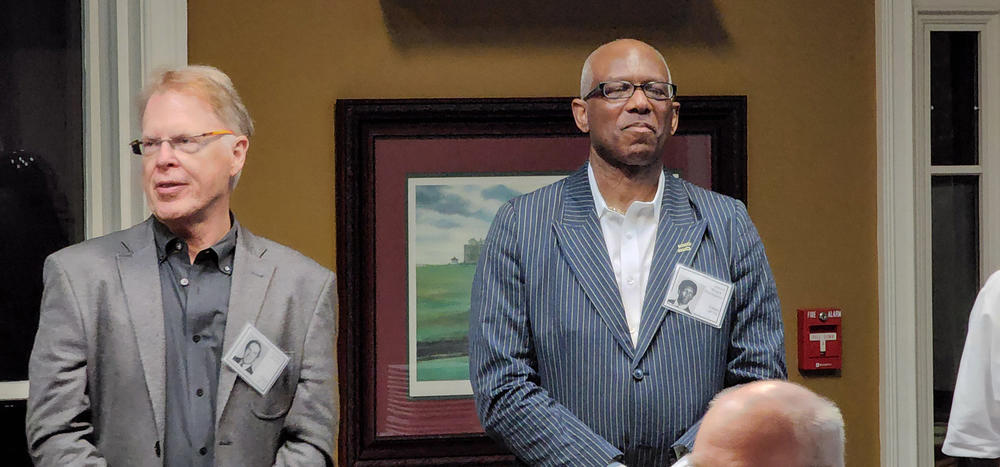
Caption
Charles McNair and James “Shack” Thompson at the Dothan High school 50th reunion. The two organized the event.
Credit: Courtesy of Dennis Lathem and Salvation South
The South has a history of racial disharmony and hatred that goes all the way back to colonial times. These days, we’re all waking up to the need to reach across the lines of race and come to a deeper and more genuine understanding. But can we really make that happen?
A few months ago, it did happen in a small city in southeastern Alabama. Salvation South Editor Chuck Reece tells the story in this week's commentary.

Charles McNair and James “Shack” Thompson at the Dothan High school 50th reunion. The two organized the event.
TRANSCRIPT:
Chuck Reece - Salvation South Editor: My friend Charles McNair is a great writer and a contributor to Salvation South, the online magazine I edit. Charles grew up in Dothan, Ala., and he graduated from high school 50 years ago with the class of 1972: the first racially integrated class at Dothan High.
Now 2020, two years before the 50-year anniversary, Charles got a call from one of his Black classmates, a man named James "Shack" Thompson. Shack told Charles that he had a dream. Shack believed that the class of 1972 should try to stage a reunion that would finally allow the Black and white classmates to break through the racial barriers and feel a sense of unity.
Charles wrote this in his Salvation South story about the reunion, "Shack explained that, since graduation, our every-10-years class reunions for the seniors of 1972 were mostly segregated. White students came, the Black ones stayed away. Too many Black students still nursed a great grievance, Shack said: They never truly felt included."
So for 18 months, Charles, Shack and 16 of their classmates worked to build a spirit of unity among all the classmates and among the committee members themselves. As the members became friends with each other. They developed a language for a series of monthly letters sent to all of the classmates, and the list grew as more and more people were located. The letters acknowledged the racial tensions in the past and told people specifically that this would be a unity reunion aimed at encouraging Black and white classmates to come together in a spirit of genuine harmony. Despite their work over nearly two years, the committee members had no guarantee that the reunion would produce the kind of unity they envisioned.
But lo and behold, it did.
Charles wrote about it this way. "Some danced. Some leaned on canes. Some sang with the band. Some sat with oxygen tanks and breathing tubes. Class members showed up blind and halt and lame, gray-haired, white-haired, bald, bewigged. And we talked openly the way we should and could have been talking for 50 years. Authentically, honestly, heart to heart, one soul to another, friends. Differences acknowledged. Differences immaterial."
An old man once told me that the key to a good life was to repeat a simple question to yourself: "What is the next right thing I can do?" Today we live in an era when all of us are called upon to reach across the barriers of race that have always separated us from our neighbors. Perhaps the next right thing for all of us is to initiate a conversation where we can acknowledge our differences and then find them immaterial because loving your neighbor as you love yourself is always the next right thing to do.
Visit us at SalvationSouth.com.
Salvation South editor Chuck Reece comments on Southern culture and values in a weekly segment that airs Fridays at 7:45 a.m. during Morning Edition and 4:44 p.m. during All Things Considered on GPB Radio. You can also find them here at GPB.org/Salvation-South.
The South has a history of racial disharmony and hatred that goes all the way back to Colonial times. These days, we’re all waking up to the need to reach across the lines of race and come to a deeper and more genuine understanding. But can we really make that happen?
A few months ago, it did happen in a small city in southeastern Alabama. Salvation South Editor Chuck Reece tells the story in this week's commentary.